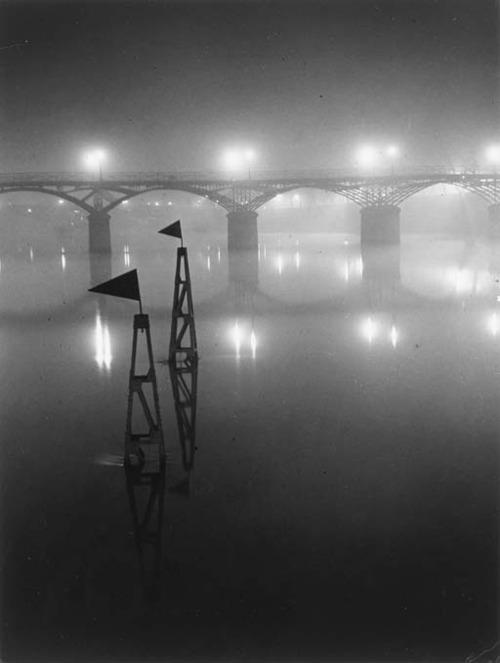The other man in the first photograph is Gyula Halász. Operating under the pseudonym ‘Brassaï’, he left his native Hungary in 1924 and moved to Paris. There he met his countryman Kertész, who introduced him to photography. Brassaï soon rose to prominence for his nocturnal urban landscapes; his first book, Paris de Nuit (1933), is a landmark in the history of night photography.
Of the photographs in this collection, the one that most concerns me is Le Pont des Arts dans le brouillard (above). Brassaï may be renowned for the eerie quality of his urban nocturnes, but as a man and a photographer he preferred the warmth of seedy music halls and the company of prostitutes. Now imagine for a moment Brassaï, a dutiful citizen of the demimonde, operating his camera in the soaking bluster of another Parisian night. The thought occurs that his intentions were not exclusively aesthetic, but perhaps in some way contractual. Consider the relationship between Brassaï and Kertész. Consider, for a moment, that photograph of them. Is it not quite apparent that some sort of deal is being struck? If I’m not mistaken (and I have studied these shots long enough by now to be certain that I am not), the two Hungarian émigrés ended up working this bridge in shifts — Kertész photographing it by day, Brassaï by night.
But why? I wrote it off for a long time as a perfectly innocent, possibly even admirable dedication to recording a city as it lived and breathed and slept. But I could never quite cast off the suspicion that the pair was waiting for someone — in other words, that the true subject of these two photos was as yet unseen. As time passed, Brassaï’s reputation as a photographer of nocturnes came to seem more and more like a convenient cover for something like surveillance activity. Facts I had previously considered unremarkable were lent a newly sinister aspect. Why, for instance, had Gyula Halász decided to take a pseudonym?
